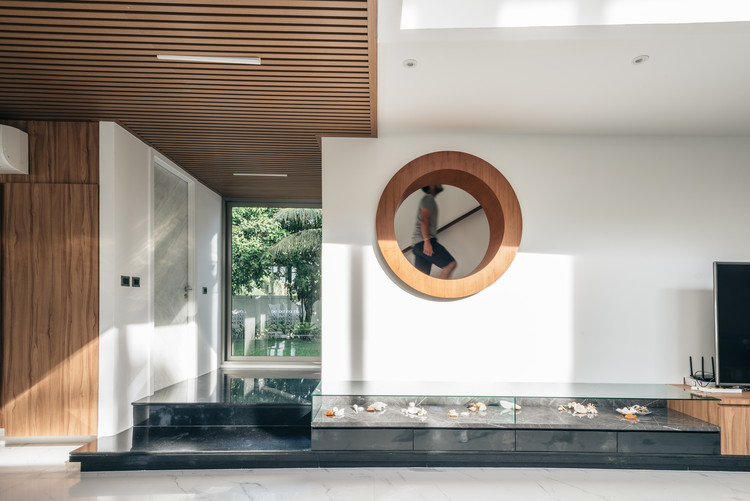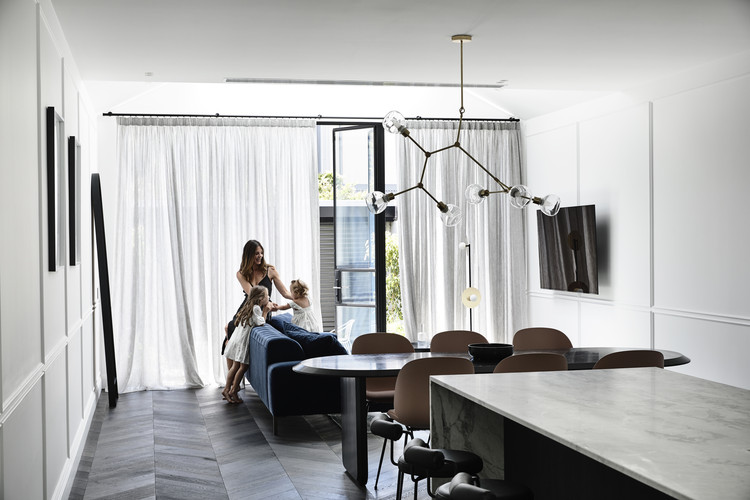Suburban Beach House David Barr + Ross Brewin
2013-05-24 01:00
架构师提供的文本描述。该项目的概念框架建立在对其正在发展的郊区环境的批评,围绕客户各自背景的类型学叙述,以及对网站本身的具体情况的回应。这座房子位于珀斯的南郊边缘地带,这个地方目前正经历着从松散的沿海城市形态的快速转变,成为珀斯沿岸其他地区的典型郊区。这所房子对在这一地区建造新的独立住房的惯例提出了挑战,因为它很小,高出地面,没有前篱笆,没有前门,没有车库,也没有砖砌的。客户是一对新婚夫妇。他,一个出生的面包西澳大利亚人,她,一个昆士兰人。类似于他们的结合,设计将这两种简陋的类型结合在一起,结合了西澳大利亚海滩小屋的轻松简约,以及传统的昆士兰长大者的气候和效用优势。这所房子抵制了平地和填土的典型方法,而是小心地在天然石灰石露头上方放置,使上面的空间能够充分利用海岸景观,而在房子下面则形成了一个有阴影的花园地形。
Text description provided by the architects. The project’s conceptual framework is built around a critique of it’s developing suburban context, a typological narrative around the respective backgrounds of the clients, and a response to the specifics of the site itself. The house is located in the southern suburban fringe of Perth, a place that is currently undergoing rapid transformation from it’s loose, coastal urban form, into a built-up suburb typical of other areas along Perth’s coast. The house challenges the conventions of new detached housing being built in the area in that it is small, raised above the ground, has no front fence, no front door, no garage, and is not made of brick. The clients are a recently married couple. He, a born and bread West Australian, Her, a Queenslander. Analogous to their union, the design brings these two humble types together, combining the relaxed simplicity of a west-Australian beach shack with the climatic and utility benefits of a traditional raised Queenslander. The house resists the typical approach of flattening and filling the site and is instead, carefully lofted above a natural limestone outcrop, allowing the spaces above to make the most of coastal views while a shaded garden terrain is created below the house.
这一设计颂扬了客户的愿望,那就是拥有一座像度假小屋那样随意的郊区住宅;一种感觉是,他们可以下班回家,立刻感觉自己就像在海滩附近一样,同时仍然受益于郊区生活所提供的连接性和服务。这座房子的设计还需要预见到它最近结婚的居民的未来,所以在房子的后部有一个额外的房间“塞”在房子下面,提供一个灵活的空间,可以是第四卧室,奶奶公寓,喧闹室,家庭办公室,或者后院凉亭。
The design celebrates the client’s desire to have a suburban home that has the casualness of a holiday shack; a sense that they could come home from work and instantly feel like they were near the beach whilst still benefitting from the connectedness and access to services that suburban living offers. The design of the house also needed to anticipate the future of it’s recently married inhabitants so an additional room is ‘tucked’ underneath the house at the rear, providing a flexible space that could be a 4th bedroom, granny flat, rumpus room, home office, or backyard pavilion.
这所房子引用了附近度假海滩房屋的卑微的重要性和规模,这曾经是这个地区的定义。然而,看似简单的风化板“棚屋”被置于地面上方,这与这些被提及的建筑物和新房子形成了动态的对比,这些建筑和新房子都坐落在被夷为平地、保留着的场地上,成为了这一地区的一种新型房屋。这个看似简单的盒子,名义上是用一系列正式的“电影”打开的,它引用了传统的窗篷,同时允许光线、空气和控制视线进出房屋,并确保隐私和遮阳。
The house references the humble materiality and scale of nearby holiday beach houses that once defined the area. However, what might appear to be a simple weatherboard ‘shack’ is lofted above the ground in dynamic contrast to both these referenced buildings and the new houses that sit heavily on their flattened, retained sites, becoming a new type of house for the area. This seemingly simple box is notionally opened with a series of formal ‘flicks’ that reference traditional window awnings while permitting light, air and controlled views into and out of the house, and ensuring privacy and shading.
为了与典型的昆士兰人保持一致,住宅的底部提供了公用设施、住房汽车、海滩用具、园艺设备和灵活的房间。上图是一套紧凑的公寓式规划,把房子分成东部简单的私人卧室和西部宽敞、共享的家庭空间,其中包括一个室外房间,为珀斯气候提供的室内/室外生活方式提供便利。这些区域被一个连续的走廊“脊梁”隔开;一个努力工作的元素,包括厨房,酒吧-b-que,卧室长袍,储藏和管道,并在南端扩大形成一个学习的角落。
In keeping with a typical Queenslander, the underside of the residence provides the utility, housing cars, beach paraphernalia, gardening equipment and the flexible room. Above, a compact apartment-like plan arrangement divides the house into simple private sleeping quarters on the east and generous, shared family spaces on the west, including an outdoor room that facilitates the indoor / outdoor lifestyle afforded by the Perth climate. These zones are divided by a continuous corridor ‘spine’; a hard-working element that contains the kitchen, bar-b-que, bedroom robe, storage and ducting, and widens at the southern end to form a study nook.
该项目是客户、架构师和建设者为实现项目的共同愿景而进行的富有成效的合作。这方面的一个关键例子是“锯齿状”镀锌钢腿和角度储藏室,从名义上大腹便便,从上面的房子的污垢。这些元素主要提供结构支撑,但精心设计和详细的方式,他们提供了有趣的,表现力的建筑特点的房子。然后,这个储藏室专门为两条长皮艇设计了尺寸。该项目面临的主要财政挑战是希望最大限度地利用周围屋顶的景观,并将现有的石灰岩山脊保存并纳入其中,所有这些都是在有限的预算范围内完成的。这导致设计了一个小型的,紧凑的房子,以抵消与提高建筑在钢结构上的相关费用。同时,外饰的目标是在使用海滩小屋的同时,实现低成本和低维护的平衡。它们包括对钢铁进行镀锌处理,将透明的纤维水泥片涂在肥皂上,将彩色的钢粘合到墙壁的表面和屋顶上。
The project was a fruitful collaboration between client, architect and builder towards a common vision for the project. A key example of this is in the ‘zig-zagging’ galvanized steel legs and the angular storeroom which notionally bellies-out from for the soffit of the house above. These elements primarily provide structural bracing but were crafted and detailed in such a way that they provide playful, expressive architectural features under the house. The storeroom is then specifically dimensioned to house two long kayaks. The key financial challenge of the project stemmed from the desire to maximise views over the surrounding rooftops and to preserve and incorporate the existing limestone ridge, all within a modest budget. This led to designing a small, compact house to offset the costs associated with raising the building high up on a steel structure. Also, the external finishes aim to achieve a balance of low-cost and low-maintenance whilst working with a beach-shack aesthetic. They include galvanised finish to steel, clear finished fibre cement sheet to the soffit and colorbond steel to the wall cladding and roof.
住宅能耗的主要因素是面积,因为它与加热和冷却的能量有关。这座紧凑型房屋的建筑面积小于150平方米,而且它的寿命将比澳大利亚平均250平方米以上的新房子消耗的能源要少得多。尽管面积很小,但这座房子仍然通过精心规划和布置开口来提供高度的空间舒适性,从而最大限度地利用北方太阳能获得和交叉通风的被动环境效益,并防止夏季西面阳光的超载。这一“小规模”的议程得到了可持续的物质使用的支持。该项目使用可回收和可再生的木材作为地板、墙壁和橱柜,从外部看,房子由于吸热能力低,寿命长,在白色的“彩色粘结”钢风化板上剥皮。人工照明是典型的LED,因为它的能源消耗和维护较低。景观设计结合了本土沿海物种,只需少量浇水。所需的浇水是由屋下的一个雨水箱提供的。此外,在现场发现的现有石灰石脊被用作天然挡土墙,使对自然地面的扰动降到最低。
The main contributing factor in energy consumption in housing is size as it relates to energy for heating and cooling. This compact house is less that 150m2 and will over it’s lifespan, consume far less energy than the average new house in Australia which is over 250m2. Despite it’s smallness, the house still delivers a high degree of spatial amenity through careful planning and placement of openings that maximise passive environmental benefits of north solar gain and cross-ventilation and prevent overloading of west sun in summer. This agenda of ‘smallness’ is backed up with sustainable material use. The project uses recycled and renewably sourced timber for flooring, walls and cabinetry and externally, the house is skinned in a white ‘colorbond’ steel weatherboard for it’s low heat absorption and longevity. Artificial lighting is typically LED for it’s lower energy consumption and maintenance. The landscape design incorporates native coastal species that require minimal watering. What watering is required, is provided for by a rainwater tank under the house. Also, the existing limestone ridge found on the site was used as a natural retaining wall, keeping disturbance to the natural ground to a minimum.
这座房子坐落在一个正在迅速失去其遗产意义的地方,这是由于一次风潮般的郊区开发,没有承认该地区独特的文化和建筑传统。例如,以前批准的规划申请是在250平方米,3个卧室的房子,2个车库和游泳池(尽管海滩只有几百米远)。这所房子被制成砖瓦屋顶,并坐在一个平地上,保留着一堵两米高的墙;这是一座典型的不合适的新房子正在该地区建造。相反,我们的项目旨在庆祝和重新解释附近的风化板和贝罗海滩棚屋的卑微的重要性、规模和形式,这些棚屋曾经界定了该地区的面积,并与该地区现有城市形式的松散和非正式合作。与街上的大多数新房子不同,这个项目在前面没有围栏。这缺乏对正面和侧面边界的严格划分,为街道提供了一种天然的石灰石露头,作为视觉上的舒适性和对陆地的欣赏。对于库吉来说,这是一座郊区的海滨别墅,对客户来说也是如此。
The house is situated in an place that is rapidly loosing it’s heritage significance through a wave standard suburban development that fails to acknowledge the area’s unique cultural and built traditions. For example, the previously approved planning application on the site was for a 250m2, 3 bedroom house, + 2 car garage and swimming pool (despite the beach being only a few hundred meters away). The house was rendered brick with a tiled roof, and sat on a flattened site, retained with a 2m high wall; a house typical of the inappropriate new housing being built in the area. Instead, our project aims to celebrate and reinterpret the humble materiality, scale and form of nearby weatherboard and fibro beach shacks that once defined the area and work with the looseness and informality of the existing urban form of the area. Unlike most of the new houses in the street, the project is left unfenced at the front. This lack of rigid demarcation of the front and side boundaries, offers the street a natural limestone outcrop as visual amenity and appreciation of the terra firma. It is a suburban beach house for Coogee as much as it is for the clients.
 举报
举报
别默默的看了,快登录帮我评论一下吧!:)
注册
登录
更多评论
相关文章
-

描边风设计中,最容易犯的8种问题分析
2018年走过了四分之一,LOGO设计趋势也清晰了LOGO设计
-

描边风设计中,最容易犯的8种问题分析
2018年走过了四分之一,LOGO设计趋势也清晰了LOGO设计
-

描边风设计中,最容易犯的8种问题分析
2018年走过了四分之一,LOGO设计趋势也清晰了LOGO设计
























































































